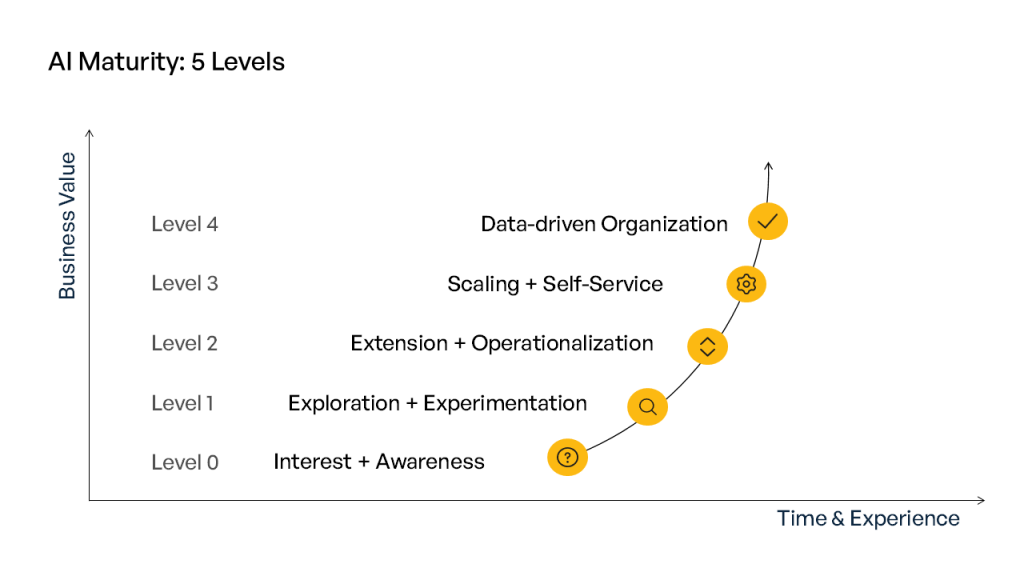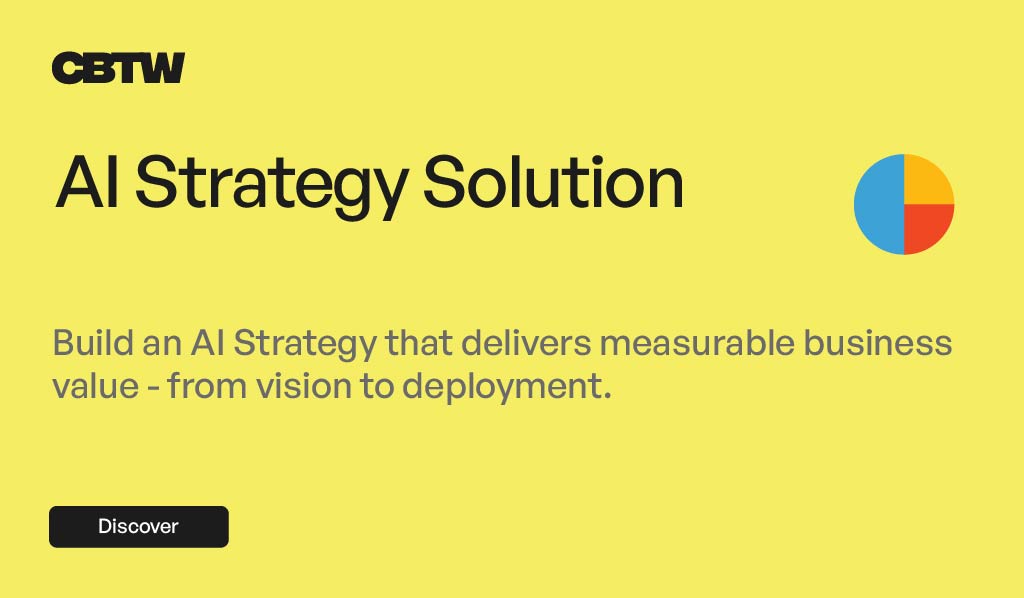Using Artificial Intelligence (AI) to drive profitability is on every leader’s mind today. Most enterprises have started to explore and experiment with many use cases. This approach is good for understanding the potential of AI. However, without an actionable strategy, it carries the risk of failure when it comes to extension and operationalization.
Avoid AI Implementation Challenge by Assessing the Level of Maturity
To understand what to do, you need to know where you are. Based on our experience over the years, we developed a pragmatic framework for organizations to assess their maturity in the use of AI.
Every organization should have a strategy for each maturity level in order to get a clear vision of what is to achieve with AI and how to get there. A well-designed AI strategy allows your organization to solve any challenges that may arise during AI Implementation.

- M-Level 0: The first phase focuses on AI interest and awareness.
- M-Level 1: The second phase focus on exploration and experimentation. During this phase, multiple POCs (Proof of Concepts) are carried out. Throughout this first two phases, no positive returns are to be expected.
- M-Level 2: Organizations start extending and operationalizing AI after initial success stories prove feasibility. During this phase, MVPs (Minimum Viable Products) replace POCs and MLOps enters the scene to determine the next phase.
- M-Level 3: When all these phases are successfully completed, it is time to scale the usage of AI and this is where all business users come into play through self-service.
- M-Level 4: In order to reach the final level of being a data-driven company, data literacy, self-service analytics and self-service AI are the most important keywords.
As companies advance in AI maturity, their return on investment increases. But, during the first two phases, an actionable strategy is often neglected. This most often leads to ongoing POCs for several months up to years. Organizations then face the challenge of operationalizing AI and remain stuck at M-Level 2.
For this to succeed, all business units and IT needs to be aligned organizationally, technically and procedurally. This alignment is much more difficult to perform when there was no AI strategy in place before. So let’s look at the most common challenges when implementing AI.
Most Common Challenges of AI for Business Implementation
Implementing AI just for AI’s sake is not a sufficient definition of goals. Neither is implementation simply because “everybody is using it”.
Clear Business Value
One of the biggest challenges faced when extending or operationalizing the use of AI is the missing formulation of clear goals and actions. Consequently, the respective steps and actions taken are difficult to derive. And as a further consequence, the organization tends to get stuck in POCs. It can also result in getting lost in detail on infrastructure or algorithms. This again leads to inefficiency and further loss of focus.
Get a clear vision and finding a focus is the goal of an AI strategy. We recommend a business-case-driven approach and assessing the expected business value of each use case in the very beginning. This approach ensures that organizations effectively combine AI and business value by design. When we know which cases we want to implement, we can derive the corresponding requirements on what we need in order to achieve this vision. This comprises all requirements for architecture, data, team size, roles and processes.
Stakeholders Alignment
A gap between the visions of the C-levels and the respective tasks to be performed in the corresponding teams to achieve this vision is observed in many cases. This gap occurs usually when there is no further definition of what is specifically to be achieved with the help of AI, meaning clear business value.
The very first thing to do is to get all stakeholders around the table with a (Generative) AI Workshop. The stakeholders must include representatives from C-level, business units and IT as the extension and operationalization of AI requires interdisciplinary teams and stakeholders.
In order to be successful, business value needs to be at the core of discussions. Even if it’s not easy to connect AI with business value right away, only a strategic approach combining innovative AI and business goals can do the job.
Expectation & Change Management
A different area of AI challenges for business strategy is closely related to this. AI is an absolute hype and fear topic and these expectations need to be managed accordingly. If people never worked with AI, it is actually hard to have an accurate level of expectations. Without ensuring AI Adoption, people are expecting too much, or not expecting enough or are even afraid of AI.
Proper change management is required in addition to managing expectations. People need to be part of the journey and need to understand the purpose of changes. Change and expectation management can both not be successful if the implementation of AI seems to be haphazard and inefficient.
Analytical Roadmap Design
The vision and the clear action plan for its realization constitute what is known as the roadmap. The entire mission of implementing AI has a clear focus as soon as the analytical roadmap is developed. The roadmap allows transparency and make it easier to get everybody on board. At the same time, this approach reduces the risk of getting lost in agile experiments in interdisciplinary fields as clear roadmapping allow for tight project control.
The combination of a clear and transparent framework through the roadmap and freedom for experimental procedures forms the perfect foundation for a successful implementation of AI.
Data Availability
The duo “Data” and “AI” can only be a winning team if we push the use of AI beyond the boundaries of data and AI teams and include all business users. If that is not managed well, there is a significant risk that chaos will take over.
The core challenge lies in data availability and ownership. Different departments often control different data sources, creating barriers when AI solutions need comprehensive datasets. Sales teams may have customer interaction data, while operations hold process metrics, and finance controls budget information.
Not only one, but all departments who are involved as AI products operators should be aligned. Especially the processes and infrastructure around AI products require a clear roadmap for all stakeholders. AI-powered solutions are complex and require interdisciplinary collaboration, making it difficult to achieve an actionable AI strategy if stakeholders work in silos.

An Actionable Strategy
A long-term strategy include planning and roadmapping. But, organizations need agile and iterative development. At the same time, only focusing on short term agility may lead to moving in the wrong direction for too long – frustration and disappointment will follow.
An actionable and appropriate AI strategy is required to avoid all these challenges. For each maturity level, the focus of the strategy changes. It is important to keep in mind the future scalability of your AI strategy right from the beginning.
No matter on which maturity level an organization is. To address AI challenges, an actionable AI strategy is key for success.
